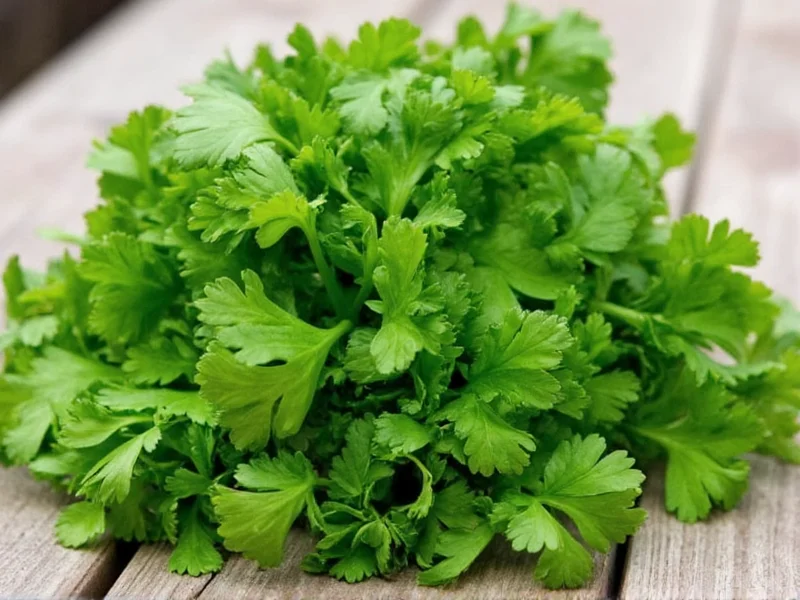Many home cooks confuse parsley and cilantro because of their similar leaf structure, but their flavor profiles couldn't be more different. Understanding these differences is essential for creating balanced dishes and avoiding culinary mishaps when following recipes that specify one herb over the other.
Breaking Down the Flavor Profiles
While both are fresh, green herbs commonly used as garnishes or flavor enhancers, their chemical compositions create dramatically different taste experiences.
| Herb | Primary Flavor Notes | Chemical Compounds | Culinary Role |
|---|---|---|---|
| Parsley (Petroselinum crispum) | Mild, grassy, slightly peppery, earthy | Myristicin, apiol, terpenes | Subtle background flavor, freshness without overpowering |
| Cilantro (Coriandrum sativum) | Bright, citrusy, lemony, with soapy notes for some | Aldehydes (decanal, dodecanal), linalool | Distinctive flavor component that defines many dishes |
Why the Confusion Persists
The visual similarity between flat-leaf parsley and cilantro leads many people to wonder does fresh parsley taste like cilantro. Both have bright green, serrated leaves that grow in similar patterns. However, closer inspection reveals key differences: cilantro leaves are more rounded with smoother edges, while parsley leaves are more pointed with crisper serrations.
This visual confusion often results in recipe disasters when cooks substitute one for the other without understanding their parsley vs cilantro taste difference. A dish calling for the subtle background notes of parsley might become overwhelmingly citrusy with cilantro substitution, while recipes depending on cilantro's distinctive flavor will lack character when parsley is used instead.
The Genetic Factor in Cilantro Perception
Approximately 21% of the population carries a genetic variation in the OR6A2 olfactory receptor gene that causes cilantro to taste like soap. This genetic predisposition explains why some people vehemently dislike cilantro while others enjoy its bright flavor. Parsley doesn't trigger this reaction in any population segment, making it a more universally accepted herb.
When exploring why does cilantro taste like soap to some people, researchers have identified specific aldehyde compounds present in both soap and cilantro that activate this genetic response. This phenomenon doesn't occur with parsley, which lacks these particular aldehydes.
Culinary Applications and Substitution Guidance
Understanding when to use each herb can transform your cooking. Chefs often describe parsley as the "background singer" of the herb world—it enhances without dominating. Cilantro functions more as a "lead vocalist," providing distinctive flavor that defines many regional cuisines.
For Mediterranean dishes like tabbouleh or gremolata, flat-leaf parsley is essential. In contrast, cilantro is indispensable in Mexican salsas, Thai curries, and Indian chutneys. When considering can I substitute parsley for cilantro in guacamole, the answer is generally no—the dish would lose its characteristic flavor profile.
That said, in emergency substitutions:
- For parsley: Try chervil or celery leaves for similar mild flavor
- For cilantro: Consider a combination of basil and lime zest for similar brightness
Storage and Freshness Tips
Both herbs require proper storage to maintain their distinctive flavors. Place trimmed stems in water (like a bouquet) and cover loosely with a plastic bag in the refrigerator. Replace water every two days. Cilantro typically lasts 7-10 days while parsley can remain fresh for 10-14 days.
Never freeze either herb whole—instead, chop and freeze in ice cube trays with water or oil. This preserves their flavor compounds better than whole-leaf freezing. When evaluating how to tell if cilantro has gone bad, look for yellowing leaves, slimy texture, or loss of vibrant aroma.
Maximizing Flavor in Your Dishes
Add parsley early in cooking for soups and stews to allow its subtle flavors to infuse. For the best parsley flavor profile in cooking, use flat-leaf (Italian) parsley rather than curly parsley, which has a more bitter edge.
Cilantro should almost always be added at the end of cooking or used raw, as heat destroys its delicate flavor compounds. The stems contain more flavor than the leaves, so don't discard them when preparing dishes that call for fresh cilantro in recipes.
Common Misconceptions Addressed
One persistent myth suggests that cooking eliminates cilantro's soapy taste for those with the genetic predisposition. Unfortunately, this isn't true—the aldehydes responsible for the soap perception remain present even when cooked. Those who dislike raw cilantro will typically dislike it in cooked applications as well.
Another misconception is that young cilantro tastes more like parsley. While immature cilantro has a milder flavor, it still contains the distinctive compounds that differentiate it from parsley. Understanding these nuances helps prevent confusion between parsley taste compared to cilantro in various stages of growth.











 浙公网安备
33010002000092号
浙公网安备
33010002000092号 浙B2-20120091-4
浙B2-20120091-4